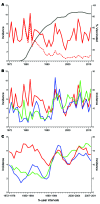Vaccination and tick-borne encephalitis, central Europe
- PMID: 23259984
- PMCID: PMC3557984
- DOI: 10.3201/eid1901.120458
Vaccination and tick-borne encephalitis, central Europe
Abstract
Tick-borne encephalitis (TBE) is a substantial public health problem in many parts of Europe and Asia. To assess the effect of increasing TBE vaccination coverage in Austria, we compared incidence rates over 40 years for highly TBE-endemic countries of central Europe (Czech Republic, Slovenia, and Austria). For all 3 countries we found extensive annual and longer range fluctuations and shifts in distribution of patient ages, suggesting major variations in the complex interplay of factors influencing risk for exposure to TBE virus. The most distinctive effect was found for Austria, where mass vaccination decreased incidence to ≈16% of that of the prevaccination era. Incidence rates remained high for the nonvaccinated population. The vaccine was effective for persons in all age groups. During 2000-2011 in Austria, ≈4,000 cases of TBE were prevented by vaccination.
Figures



References
-
- World Health Organization. Vaccines against tick-borne encephalitis: WHO position paper. Wkly Epidemiol Rec. 2011;86:241–56. - PubMed
-
- Centers for Disease Control and Prevention. Tick-borne encephalitis among U.S. travelers to Europe and Asia—2000–2009. MMWR Morb Mortal Wkly Rep. 2010;59:335–8. - PubMed
-
- Reusken C, Reimerink J, Verduin C, Sabbe L, Cleton N, Koopmans M. Case report: tick-borne encephalitis in two Dutch travellers returning from Austria, Netherlands, July and August 2011. Euro Surveill. 2011;16:20003. - PubMed
-
- Simmonds P, Becher P, Collett MS, Gould EA, Heinz FX, Meyers G, et al. Family Flaviviridae. In: King AMQ, Lefkowitz E, Adams MJ, Carstens EB, editors. Virus taxonomy. IXth Report of the International Committee on Taxonomy of Viruses. San Diego: Elsevier Academic Press; 2011.
Publication types
MeSH terms
Substances
LinkOut - more resources
Full Text Sources
Other Literature Sources
